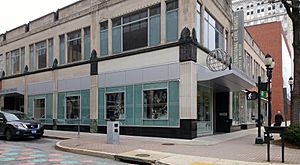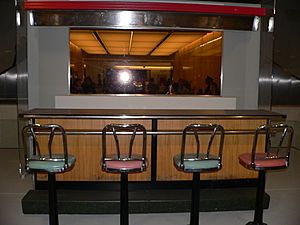International Civil Rights Center and Museum facts for kids
 |
|
 |
|
| Lua error in Module:Location_map at line 420: attempt to index field 'wikibase' (a nil value). | |
| Established | 2010 |
|---|---|
| Location | 134 S. Elm Street Greensboro, North Carolina |
| Type | Civil and political rights |
| Visitors | 70,000+/- annually |
The International Civil Rights Center & Museum (ICRCM) is a special museum in Greensboro, North Carolina. It is located in a building that used to be a Woolworth's department store. This store is famous because it was the site of an important, peaceful protest during the civil rights movement.
On February 1, 1960, four brave African American college students sat down at the store's lunch counter. At that time, the counter was "whites only," which was a form of unfair separation called segregation. The students, known as the A&T Four, were Franklin McCain, Joseph McNeil, Ezell Blair Jr., and David Richmond. They politely asked to be served and refused to leave when they were denied service.
Their protest, called the Greensboro sit-ins, inspired many others. The next day, twenty more students joined them. Soon, people all over the country were holding similar sit-in protests. The museum was created to honor the courage of the A&T Four and everyone who fought for equal rights. It opened on February 1, 2010, exactly 50 years after the first sit-in.
Contents
History of the Building
The building was constructed in 1929 in the popular Art Deco style of that time. Before it became a Woolworth's store in 1939, it was known as the Whelan Building. The Woolworth's store had a large lunch counter with 69 seats.
The Greensboro Sit-Ins
The sit-ins at the Woolworth's lunch counter began on February 1, 1960. The four students from North Carolina Agricultural and Technical State University started a movement that spread quickly. Thousands of people joined protests at Woolworth's and other segregated stores in the South.
These peaceful protests and boycotts (where people refuse to buy from a business) caused sales to drop. On July 25, 1960, the manager of the Greensboro Woolworth's finally agreed to desegregate the lunch counter. This meant anyone, no matter their skin color, could eat there. This victory helped lead to the Civil Rights Act of 1964, a law that made segregation illegal in the United States.
A few years later, the lunch counter was remodeled. The stools were removed and then put back in different spots. Because of this, we don't know exactly which four stools the students sat on that first day.
Saving a Historic Place
In 1993, the Woolworth company announced it was closing many of its stores, including the one in Greensboro. Many people wanted to save the building because of its important history. Local leaders Melvin "Skip" Alston and Earl Jones started a nonprofit group called Sit-In Movement, Inc. Their goal was to turn the building into a civil rights museum.
In 1994, just before the store closed, the bank that owned the building agreed to sell it to their group. A part of the original lunch counter with four stools was sent to the Smithsonian Institution's National Museum of American History in Washington, D.C.
Creating the Museum
Turning the old store into a museum was a big project that took many years and a lot of money. The community, the state of North Carolina, and the U.S. government all gave money to help.
Financial Challenges
The project faced some money problems along the way. At times, it was difficult to raise all the funds needed. In 2013, the city of Greensboro gave the museum a loan to help. The museum worked hard to raise money and was able to pay back its debts by 2018.
Grand Opening
As the 50th anniversary of the sit-ins approached, people worked hard to finish the museum. They raised over $23 million through donations and special tax credits for saving historic buildings.
The International Civil Rights Center & Museum officially opened on February 1, 2010. The three living members of the Greensboro Four were the guests of honor. Many important people, including government leaders and Reverend Jesse Jackson Jr., attended the opening ceremony.
Museum Exhibits
The museum has about 30,000 square feet (2,800 m2) of exhibit space. Visitors can take guided tours to learn about the history of the civil rights movement.
The tour starts by showing what life was like in the 1960s under segregation. One powerful exhibit is the "Hall of Shame," which shows the violence that peaceful protesters faced. Visitors also see a recreation of the A&T college dorm room where the four students planned their protest.
The main exhibit is the original L-shaped lunch counter, set up just as it was in 1960. Life-sized videos help visitors imagine what it was like to be there during the sit-ins. Other exhibits explore the role of churches, schools, and the government in the fight for equality. You can see artifacts like a pen used to sign the Voting Rights Act of 1965 and the uniform of a Tuskegee Airman from Greensboro. There is also a robe and hood from the Ku Klux Klan, a group that promoted hate and discrimination, to show what civil rights activists were fighting against.
Awards and Events
The museum gives out the Alston-Jones International Civil and Human Rights Award. This award honors people who have made a big difference in fighting for human rights. The famous author Maya Angelou received the award in 1998. In 2013, the award was given to Dr. Johnnetta Betsch Cole, a respected educator and former director of the Smithsonian's National Museum of African Art.
The museum also hosts an annual Black and White Ball to raise money and celebrate its mission.
In 2016, the museum was asked to close for several hours for a visit by presidential candidate Donald Trump. The museum's leaders declined the request because they did not want to close their doors to the public during normal hours.
Future Plans
In 2022, the museum purchased the building next door to create more space for exhibits and programs. This expansion will help the museum in its goal to become a UNESCO World Heritage Site. A World Heritage Site is a place recognized as having special cultural or physical importance to the world.
See also
- List of Woolworth buildings
- Sit-in movement
- State v. Katz
- Timeline of the civil rights movement



